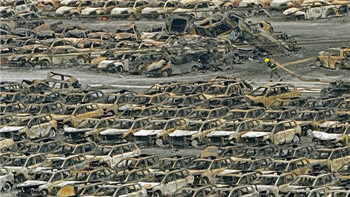
Last Thursday morning I was on the bus to work in the central business district of Beijing, browsing social media and loathing myself for obsessing over posts about fashion, when I saw a picture of black and purple smoke rising over thousands of completely burnt-out cars. News travels fast in China these days. The photo was reposted by a friend of mine, who is from Tianjin. It looked like a war zone.
上周四早晨,我坐在公交车上,要到北京中央商务区(CBD)去上班。我一边浏览着社交媒体,一边为自己沉迷于时尚类帖子而自我唾弃,这时我看到了一张照片:在数千辆完全被烧毁的汽车上空,冒着黑色和紫色的浓烟。如今,新闻在中国传播得很快。这张照片是天津的一个朋友转发的。那场景看起来像战场。
The last time I saw something this terrifying was seven years ago. Back then I was working as a journalist for the Chinese state media, and on the afternoon of May 12 a friend called to tell me there had been a major earthquake near his home town in Sichuan province. He hung up in a rush, saying he needed to check if his parents were safe.
上一次我见到同等级别的可怕场景还是在7年前。当时我是中国官方媒体的一名记者。那年5月12日下午,一位朋友打电话给我,说他在四川省的老家附近发生了大地震。他匆忙挂断电话,说要打回去看看自己的父母是否平安。
In 2008 it was unusual for breaking news to arrive via your phone. Facebook and Twitter were already blocked to most Chinese internet users. Weibo, which has been called the Chinese version of Twitter, did not yet exist. Neither did WeChat — now China’s most widely used social media platform and the one on which I heard about last week’s tragedy in Tianjin. It would not be launched for more than two years.
2008年时,通过手机收到突发新闻还不常见。大多数中国网民已经无法使用Facebook和Twitter。被称为中国版Twitter的微博(Weibo)还未诞生,也没有微信(WeChat)——两年多后微信才问世,如今已是中国使用最广的社交媒体平台。也正是通过微信,我得知了上周发生在天津的惨剧。
A week after my friend’s distraught call, I went to Sichuan with a group of fellow reporters to report on the aftermath of the earthquake. The closer I got to the reality of the disaster, the more distant I was from information about it: we were on the move constantly with no radio and no newspapers; my mobile phone was disconnected quite often due to bad reception.
接到朋友焦虑不安的电话一周后,我和一群记者同行赶赴四川,报道震后灾情。我越接近灾难现场,就离这场灾难的信息越远:我们一路奔波,听不到广播,也没有报纸;由于信号不好,我的手机经常连不上网络。
I had the chance to talk to survivors, shed tears with them, and we faced the fear of aftershocks, flood and contamination together. We were all scared. But at least we knew what was happening — unlike many farther away, who relied on what second-hand information they could obtain.
我抓住机会与幸存者交谈,跟他们一起流泪,我们共同面对余震、洪水及污染所带来的恐惧。我们都很害怕,但至少我们知道这里发生了什么——不像外面的人,只能依赖他们能够得到的一些二手信息。
No one had to rely on such reports last week. Still on the bus in Beijing, I sent an instant message to my friend. “A disaster,” she replied, “like the end of the world. Fortunately my parents were living far enough away, so they are OK.”
上周的爆炸发生后,人们不必再依赖此类报道。还在北京公交车上时,我给朋友发了一条信息。“一场灾难”,她回复说,“像世界末日。幸亏我父母住得足够远,所以他们没事。”
You did not have to know someone in the stricken city to know what was going on. My smartphone buzzed with all sorts of information: pictures of the blast site, apparently taken by a drone; video footage of the shock wave; logs written by reporters on the scene.
你不必认识受灾城市的人就可以获悉那里发生了什么。我的智能手机不停地收到各种信息:爆炸现场的照片(显然是由无人机拍摄);爆炸冲击波的视频;现场记者所写的日志。
A photographer with the nickname X-ceanido uploaded images to WeChat after spending Thursday in the ruins. Within 24 hours these cruelly graphic pictures, accompanied by a diary-style report, had been viewed 100,000 times and attracted more than 2,000 comments. They were deleted, probably by internet censors, only to pop up again every time they were taken down.
一位网名为X-ceanido的摄影师上周四在废墟中忙碌了一天,随后他将所拍照片上传到微信。24小时内,这些惨烈的图片伴随着一篇日记风格的报道已经被阅读了10万次,吸引了2000多条评论。这些照片被删除了(很可能是互联网审查者所为),但每次它们被撤下后都会很快再次出现。
At home that evening I tuned my television to a Tianjin station and steeled myself for more horrifying footage. What I saw shocked me for a different reason: the channel was broadcasting a Korean television drama. There was nothing about the explosions. Eventually the schlocky romance was turned off and some newsreaders came on, reading carefully written statements from a teleprompter. The city authorities held press conferences, each one as brief as possible — although some of them ended awkwardly, with critical questions left unanswered, prompting more criticism online.
那天晚上回家后,我打开电视,调到天津一电视台,并做好了心理准备,以为自己会看到更多恐怖镜头。我确实看到了令自己震惊的一幕,但不是因为恐怖的画面,而是因为该台居然在播放韩国电视剧。没有关于爆炸的报道。最终,蹩脚的电视剧被停掉,新闻播报员出来了,小心翼翼地宣读着台词提示器上的书面声明。天津市政府举行了多场新闻发布会,每一场都尽可能地简短——有些发布会尴尬收场,而关键问题没有得到回答,在网络上引发了更多批评之声。
While information is now easier to come by, hard facts are not. The fragmented sources on social media are bewildering; some offer solid reporting, but others can be subjective and inaccurate. It is difficult to tell which are which. Advanced technology has provided an escape from the censorship. But we are at risk of replacing silence with indecipherable noise. It is sometimes difficult to believe anything unless you see it with your own eyes or hear it from someone you trust.
虽然如今人们可以更容易地获取信息,但得知真相并不容易。社交媒体上分散的信息来源让人眼花缭乱;有些提供扎实可靠的报道,还有些可能是出于主观想法的,或者是不准确的。很难分辨这些信息的真假。先进的技术提供了逃避审查的方法。但我们面临一种危险:沉默被打破时,取而代之的是各种难以分辨的嘈杂声。有时候很难相信任何信息,除非亲眼见到或者从信任的人那里听到。
And silence has a way of coming back. Three days after the explosions, some popular posts seemed to have been deleted. A Weibo message recording the explosion, which had been posted by a nearby resident on the evening it happened, had somehow disappeared into thin air. The authorities have arrested some people who posted online, accusing them of “scamming”. Hundreds of social media accounts have been shut down on the grounds that they had been used for “spreading rumour”.
而且,沉默会以自己的方式回归。爆炸发生三天后,一些人气很旺的帖子似乎已被删除。一条爆炸现场附近居民当晚所发的、记录爆炸过程的微博已经消失得无影无踪。当局逮捕了一些在网上发帖的网民,指控他们“欺诈”。数百个社交媒体账户被封杀,理由是它们被用于“散布谣言”。
On Monday night, nearly five days after the blasts, official television was reporting that least 114 people had died and 70 were missing. Whether any local officials were expected to be held responsible, it did not say. As to why dangerous chemicals were being stored only hundreds of metres from residential buildings where tens of thousands of people live, there was no definitive official answer.
截至周一晚,在爆炸发生近五天后,官方电视台报道,至少有114人死亡,70人失踪。报道中未提及是否有任何当地官员将对此次事故负责。至于为什么危险化学品被存储在距离有数万人口的居民点只有几百米的地方,还没有明确权威的官方答复。











